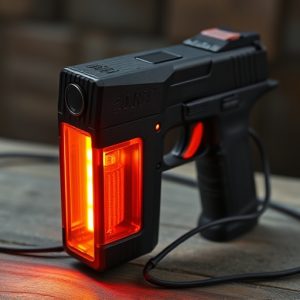Decoding Runt Stun Gun Voltage: Safety & Effectiveness for Self-Defense
Runt stun guns are compact self-defense devices that offer a balance between power and safety, with…….
Runt stun guns are compact self-defense devices that offer a balance between power and safety, with voltage ratings ranging from 650,000 to 1,000,000 volts. These gadgets deliver high-voltage shocks that can incapacitate an attacker without being lethal, making them a safer alternative to other self-defense tools. Users must exercise care due to the high voltage involved. Safety measures include proper storage and ensuring contacts are covered when not in use. The effectiveness of a runt stun gun isn't solely determined by its voltage but also by factors like amperage, current delivery capacity, electrode probe design, and battery life, which influence shock consistency and performance during self-defense situations. Additionally, the integration of a bright LED flashlight in many models enhances visibility and safety. It's important to be aware of the legal considerations surrounding runt stun guns and to understand their capabilities and limitations for effective use in personal defense scenarios where lethal force is not required. Training is essential for proficient handling and aiming, given the precision needed with these devices. In summary, runt stun guns are a portable and potent option for personal defense, provided users adhere to safety guidelines and legal requirements and receive proper training.
When discussing the capabilities and safety aspects of self-defense tools, understanding the voltage of a runt stun gun is paramount. This article delves into the technical specifications that define its effectiveness and explores how these devices function within various legal frameworks and real-world scenarios. From the basics of electrical output to the practicalities of their use, readers will gain a comprehensive view of what makes a runt stun gun a reliable choice for personal safety.
Understanding Runt Stun Gun Voltage: The Basics and Safety Considerations
When engaging with a runt stun gun, it’s crucial to grasp the electrical specifications that define its capability and operational safety. Runt stun guns, despite their compact size, are designed to deliver an electric shock for self-defense purposes. The voltage of these devices plays a pivotal role in their effectiveness; typically, they operate within a range that can incapacitate an attacker without causing lethal harm. Understanding the voltage is essential as it dictates how strongly the device can deliver its charge. A standard runt stun gun might have a voltage rating anywhere from 650,000 to 1,000,000 volts, which is sufficient for self-defense but not lethal. However, the actual shock delivered is much less because the voltage is stepped down through the stun gun’s circuitry to a safer level for use. It’s imperative to handle these devices with care, as the high voltage can be dangerous if misused or mishandled. Safety considerations include proper storage, ensuring the contacts are covered when not in use to prevent accidental activation, and understanding the legal implications of carrying such a device. Users should also be aware that the effectiveness of a stun gun is not solely dependent on voltage but also on factors like amperage, current delivery capacity, and the design of the electrode probes. Therefore, when selecting a runt stun gun for personal defense, it’s advisable to consider both the voltage rating and other important features that contribute to its overall effectiveness in a self-defense situation.
Technical Specifications of Runt Stun Guns: Voltage, Capacity, and Effectiveness
Runt stun guns are compact self-defense devices that deliver a high-voltage electrical shock to incapacitate an attacker. Despite their smaller size, which might lead one to underestimate their power, these units are designed with efficiency in mind. The voltage output of a runt stun gun typically ranges from 65,000 to 1,000,000 volts. This high-voltage capability is complemented by a rechargeable battery that ensures the device operates reliably when needed. The effectiveness of these stun guns lies not only in their high voltage but also in their electrode configuration and the amperage delivered. The combination of a powerful electric charge with a focused delivery system can be quite formidable, creating a disorienting sensation for an assailant, effectively serving as a deterrent.
When assessing the technical specifications of runt stun guns, it’s important to consider not just the voltage but also the capacity of the device’s battery and its ability to deliver a consistent and powerful shock. A runt stun gun with a longer-lasting battery can provide multiple shocks if necessary, which is a critical feature in self-defense situations where immediate follow-up actions might be required. Additionally, the bright LED flashlight integrated into many models enhances visibility during confrontations, adding another layer of safety for users. Overall, while these devices may be smaller and more concealable than other stun guns, their specifications demonstrate that they are a viable option for personal defense when it comes to voltage, capacity, and effectiveness.
Real-World Application of Runt Stun Guns: Legalities, Training, and Use Cases
Runt stun guns, characterized by their lower voltage compared to their full-sized counterparts, remain a topic of interest and controversy in personal defense arsenals. Despite their diminutive size, which often leads to the misconception that they are less effective, these devices can still deliver a shock sufficient to incapacitate an assailant. In terms of legalities, the possession and use of stun guns are regulated on both the state and federal levels in the United States, with varying laws dictating who may legally carry one. Users must be well-versed in their local regulations, as unauthorized possession can lead to serious legal consequences.
Training is a critical component when it comes to effectively using a runt stun gun. Unlike larger models, the compact size of these devices requires precise handling and aiming. Proper training ensures that individuals understand not only how to deploy their stun gun safely but also in what situations its use would be justified and effective. Use cases for runt stun guns are diverse, ranging from personal defense scenarios where lethal force is not an option or desired, to situations where the individual’s size or physical capabilities are a factor. In each case, the key to successful deployment lies in the user’s familiarity with the device and their understanding of its limitations and potential within various self-defense contexts.


